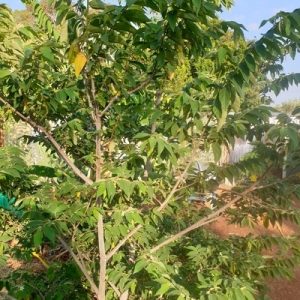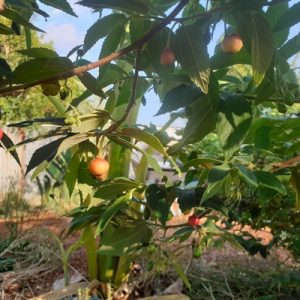Muntingia calabura
Panama berry, calabura, capulin
Origin
The neotropics, including southern Mexico, Central America and tropical South America to Peru and Bolivia; now distributed pantropically.
Climate
In native areas it’s found up to elevations of 1200m with annual precipitation of about 1000mm. Nevertheless, when mature it has some tolerance to dry seasonal periods.
Plant Description
Capulin is a small fast growing short-lived evergreen pioneer species that is semi-evergreen with dry conditions. It grows to 3-10m with a smooth brown trunk 15-20cm dia and has spreading plagiotropic branches, pendent toward the tips. The leaves on 3-7mm petioles are distichous, simple alternate pubescent oblong-ovate, 4-10cm X 1-5cm with serrate margins, dark green above and lighter below. Mainline branches become erect after leaf fall & so contribute to the formation of the trunk.
Relatives
It is the only species in the genus Muntingia in the Muntingiaceae family, formerly Elaeocarpaceae or Flacourtiaceae.
Soils
Tolerant of relatively poor soils under acidic and alkaline conditions but less so of salt and calcareous soils. The preferred soil pH is 5.5-6.5.
Propagation
Propagation is normally by seeds in the wild and under cultivation. They should be free of surrounding inhibitory pulp, achieved either by repeated washing and straining or in the wild by passage through the gut of dispersers. Optimal temperature for germination is 35°C and as a pioneer species it’s not unexpected that continuous exposure to light increases germination success There is no advantage with vegetative propagation.
Cultivars
None established but yellow and white skinned types are known.
Flowering and Pollination
Fascicular inflorescences are supra-axillary (up to half-way along from internodes) consisting of 1-3, sometimes up to 5, hermaphrodite self-compatible pentamerous flowers about 2cm in diameter. Pedicels are 1-2cm long, the green sepals are lanceolate, and petals are white or rarely pink with a wavy margin. There are numerous stamens with slender filaments and yellow anthers; each anther contains thousands of pollen grains. The superior pyriform glabrous ovary has a thick short style and a 5- lobed stigma with the nectary behind the base of filaments. Two behavioural traits are notable. First, the proportion of stamens varies across flowers within a fascicle, with low numbers (20 or less) and a well-developed pistil in the first opening flower, and high numbers (100 or more) and a poorly developed pistil in the last opening. Fruit set is higher with early opening flowers, and plants can adjust the male/female development depending on conditions and resources. Second, flowers open at dawn and only last a day. A series of pedicel movements lifts each flower above the plane of the branch just before anthesis to assist pollination, then the flower is moved to a permanently pendent position within 2 days from fruit set, so minimising interference between pollinators and frugivore dispersers. This is thought to have been an evolutionary outcome in native areas where there is continuous flowering and no clear temporal separation of these two vectors. Pollinators are insects, mainly bees. Flowers that don’t set fruit abscise over several days.
Cultivation
No horticultural work has been done, but as a rapidly growing pioneer species in open disturbed areas it usually needs little care and prefers full sun. It could be expected as a continuously flowering species dependent on growth that management should encourage vegetative development throughout the year.
Wind Tolerance
Branches are prone to breakage in strong winds.
Pruning
Regular maintenance pruning will guard against branch breakage.
The Fruit
The sub-globose fruit is a berry, 4-12 X 4-10mm, with a smooth pale green skin turning red on ripening. The light brown flesh has a sweet taste with a musky odour and contains thousands of tiny small greyish-yellow seeds. The fruit and associated leaf develop concurrently, with fruit maturing before the leaf abscises. Ripe berries contain about 18% carbohydrate and have more vitamin C than oranges.
Fruit Production and Harvesting
The juvenility period is only 2-3 yrs. In tropical climates fruit will crop throughout most of year, but it’s likely in our sub-tropical climate that it will exhibit variable seasonal production. Ripening takes 6-8 wks from anthesis and fruit set.
Fruit Uses
The sweet ripe fruit is usually eaten fresh but can be processed into jams or cooked in tarts.
Pests and Diseases
Fruit fly problems have been reported in some regions. Some trees are totally pest free while others are susceptible to attack, a phenomenon not yet studied or understood.
Comments
With its vigorous growth and widespread seed dispersal, Panama berry is regarded as invasive in some countries. Selfcompatibility is a plus, meaning only one plant is needed to obtain fruit. The small fruit size is seen as a disadvantage by many, but the small size of blueberries has not held back their popularity. An advantage for the home grower is that fruit don’t ripen all at once but over an extended period. It could probably be grown very easily in pots.

